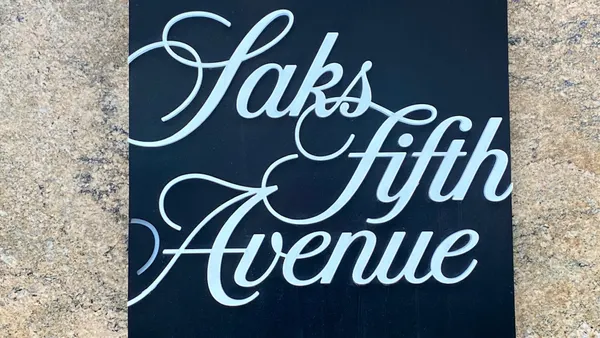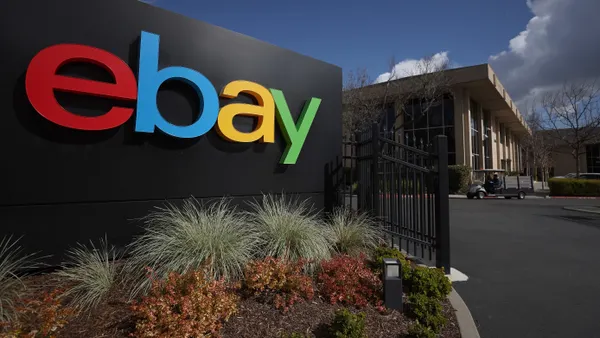Dive Brief:
- Revenues for marketplace platform providers across the globe are predicted to more than double from $18.7 billion in 2017 to $40.1 billion in 2022, driven by the sharing economy, according to a report from Coresight Research and data by Juniper Research. The Americas will represent 57.2% of the 2022 total.
- While virtual marketplaces like Amazon's and eBay are top-of-mind, this concept is about more than selling products. These portals serve consumer demand for resale and rentals, as well as for finding and booking services.
- Walmart’s announcement of an online Lord & Taylor store this week represents a new evolution of online marketplaces into e-commerce malls, expanding and enhancing the products and image of the host.
Dive Insight:
Amazon quietly transitioned the name of its "Amazon Marketplace" to "Amazon Services" earlier this year, and this represents more than an attempt to sidestep some thorny image issues like the sale of counterfeit goods and taxation questions. The opportunities for third-party online marketplace selling have increased greatly of late, both for retail products and services such as assemblers, house cleaners, handymen, hospitality and restaurants. Airbnb, for example, has created a new market niche — short-term rentals of privately-owned real estate. Uber and Lyft have permanently disrupted the livery business with their pools of private contractor drivers.
The overall business of virtual marketplace platforms is in the midst of a massive expansion in all areas. In 2016, shoppers did half of their e-commerce spending through marketplaces and this could increase to two-thirds in five years, according to a Forrester Research study. The recent report from Coresight Research helps to categorize and identify some of the major trends, sectors and companies involved in the online marketplace economy.
There are three broad marketplace trends, as identified by Coresight: vertical marketplaces for specific categories, local marketplaces like international platforms Flipart in India and Alibaba in China, and an evolution of ancillary services that support sharing economy marketplaces such as insurance provider Guardhog. These do not include marketplaces for illegal or borderline-legal products and services on the so-called dark web.
Online marketplaces for products are currently the most prominent. They involve an exchange of a product for money, which could be for a new product, a used product, or the rental of a product for a limited time.
These platforms serve as a virtual marketplace for third-party sellers. These might include large retailers and brands, as well as smaller retailers and individuals. Purchase convenience, access to a large number of buyers and sellers, and the ability to compare prices are key advantages in the growth of marketplace platforms, said Coresight.
Among the popular platforms, Amazon is of course a leader worldwide and eBay is also a major player. Niche product platforms like Etsy and the lesser-known Witchsy — "a curated marketplace for artists" — are also available.
Traditional retail businesses must adjust to these marketplaces including department stores, off-price retailers and specialty big box stores and need to develop strategies that involve either competing, or participating with the marketplaces.
Then there is Walmart, which is increasing its own third-party selling opportunities online even as its Jet.com acquisition is moving away from marketplaces. Walmart said this week it would roll out a digital Lord & Taylor flagship store on its new "fashion destination" part of a new web mall including 125 premium brands. This is in line with a trend of online retailers evolving their marketplaces into online malls. Amazon has set similar deals with Land’s End, Nike and Sears for DieHard batteries and tires, and Kenmore appliances.
Resale marketplaces, or re-commerce, enable sellers to set their products apart from conventional retail marketplaces where new products are sold, Coresight noted in its report. A June 2017 Statista survey cited by Coresight found that about 75% of American consumers have bought a used item at least once in the last year.
Among the popular resale marketplaces named by Coresight are ThredUp and Poshmark. According to ThredUp’s Annual Resale Report 2018, the online and offline market for used apparel was $20 billion in 2017 and will reach $41 billion by 2022. Apparel was 49% of the total resale market last year and two emerging resale platforms are Rebag for luxury designer bags, and Furnishare which offers a turnkey solution for buying and selling used furniture.
Rental marketplace platforms list items owned by individuals that are available to rent to others on a temporary basis. The Coresight report includes Statista numbers showing that cars top the list of rented items (19%), followed by PCs or laptops (16%), smartphones (15%), TVs (12%), followed by various other categories with 10% or less. "I would not rent anything" was cited by 59%.
Apparel is becoming a popular rental category, especially among millennials, Coresight noted. About 60% of millennials prefer renting goods to owning them, according to a 2013 U.K. report by the Organisation for Economic Co-Operation and Development. Rent the Runway has been one of the most successful startups in apparel, offering designer-branded fashion rentals, including special occasion dresses and outfits.
"We expect to continue to see growth and evolution in marketplace platforms across industries," Coresight concluded. "Retail marketplaces allow a larger number of buyers and sellers to engage with each other on a common platform, while resale and rental marketplaces continue to drive growth in the sharing economy. In the U.S. in recent years, it is now as easy to buy services as it has long been to buy products."











